Extended Pentatonic Structures - A Handful of Blues
This lesson provides a visual exploration of some of the ways we can extend the 5 basic
pentatonic shapes that were presented in
Lesson 10.
This topic is not really an "advanced" one, but it is something that I want to talk about because
I use these ideas all the time when improvising - they're important. So without further ado...
extended pentatonic structures.
The Foundation Patterns
Using G as a root, let's revisit the two "main" or "foundational"
patterns for a minor pentatonic scale - Pattern 1 (which has its root on the
6th string) and Pattern 4 (which has its root on the 5th string). What's great
about these two patterns is that together they cover a lot of ground or fingerboard.
Check it out:
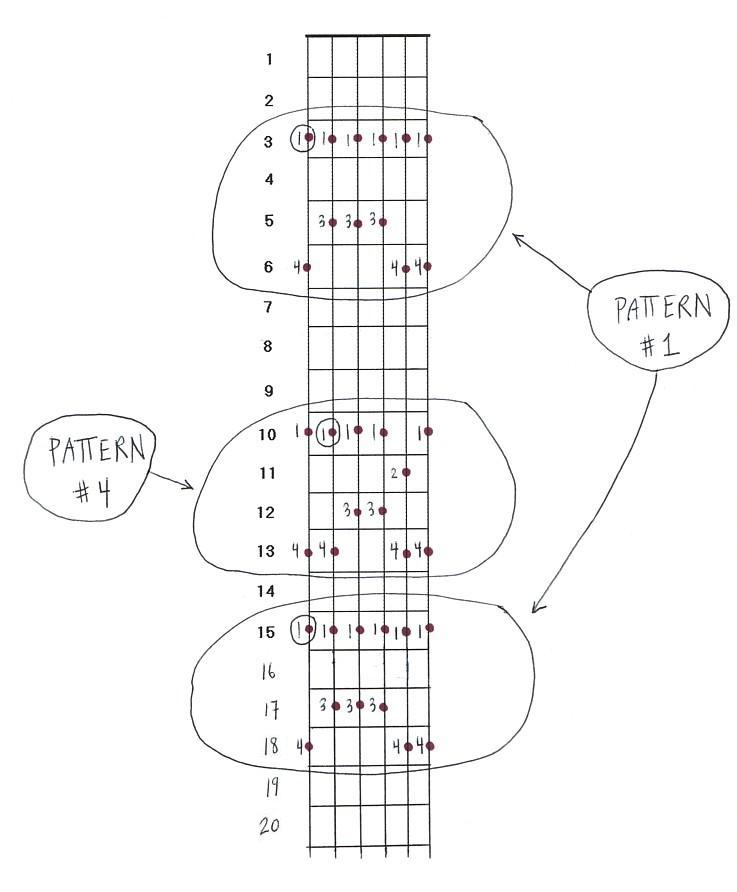
Diagram 1: The Two "Main" Minor Pentatonic Patterns in Gm
Interestingly enough, Pattern 5 is also depicted in this picture. Look at 12th position above;
Pattern 5 is the "hidden" pattern that connects Pattern 4 and Pattern 1.
Tricky, eh? So, we really have three different patterns depicted here on the fretboard.
And of course, when we repeat the Pattern 1 up one octave, almost the whole fingerboard
becomes available to us. But, hopefully, this is nothing new to you.
Pentatonic Boxes - Pattern One
Now, let's extend the bottom part of Pattern 1 and see what we get:
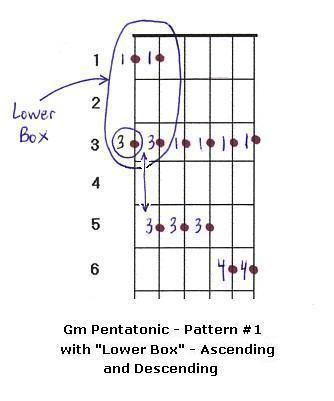
Diagram 2: Pattern 1's "Lower Box"
The box is comprised of the bottom four notes in the diagram
above. And, of course, it's called a box for obvious visual reasons - you can connect
the four notes with a box or rectangle - which is a kind of box. Where does the box come from?
Well, you should know the answer to this question. (I told you this is not really an advanced
lesson, but you'd be surprised how lazy students can be, so humor me.) Pattern 5 of course!
Be sure to consult
Lesson 10
if you need to refresh your memory.
The point: Boxes are a nice way to abstract or "mentally
group" 4 or 5 notes together. They're great little structures to hang around in because
so many guitar licks can be played with them.
Notice too that Pattern 1's lower box enables us to be more "first/third finger-centric" with
respect to our left hand? This is always nice for guitar players (as you probably already
know) since so many pentatonic licks are played using these two fingers.
Also notice: the fingering shown here is a good one to use for both ascending
and descending the scale. That is, be sure to use your third (or ring) finger when sliding
between the 3rd and 5th frets on the "A" string. However, fingerings are always determined
by what you are trying to play, so... sometimes it's appropriate to switch positions or slide
with the first finger.
Now let's expand Pattern 1's upper register to see what we get:
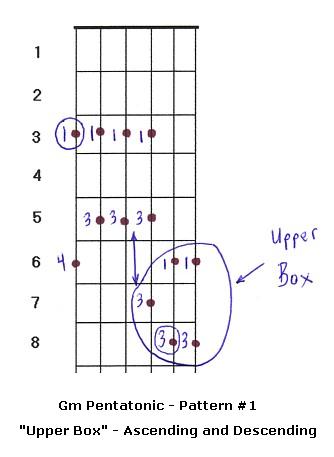
Diagram 3: Pattern 1's "Upper Box"
The upper box in this case "borrows" notes from Pattern 2. Also, the fingerings shown
here are good for both ascending and descending the scale. That is, when
changing positions on the "G" string (the sexiest string on the guitar) we use the third finger
to perform both an upward and downward slide. Note, however, if we were to stay in
the upper box, then we would use the second finger instead of the third to play the "D" note
at the 7th fret (on the "G" string.) See diagram 4 directly below for what I mean...
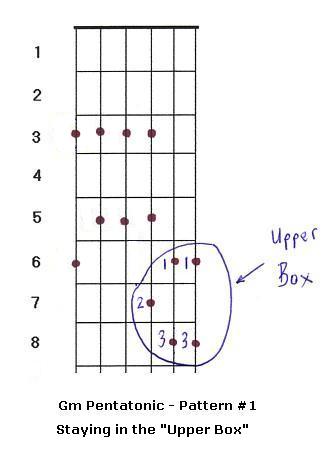
Diagram 4: Fingerings For Staying in Pattern 1's
"Upper Box"
Again, this box contains oodles and oodles of guitar licks. It's literally... "a handful
of Blues". Now, combining both upper and lower "boxes" (shown thus far) with Pattern 1,
we get the following extended pentatonic structure.

Diagram 5: Pattern 1 Extended Structure
This extended pattern enables us to cover 8 frets - twice as many frets than if we were to
just stay within Pattern 1 without switching into any of the boxes. We also have notes
above and below each root of the scale which is essential for "riffing" and playing licks.
Now, that's cool.
Now you may be asking yourself, why aren't I showing you any guitar licks? I suppose that that's
a reasonable question, but the truth be told... you should learn them on your own by listening to
your favorite albums/CDs. That's how I learned them and that's how you should learn
them too. There's no easy way out, you have to put in the work. Of course, you could find
tableture for most classic guitar solos these days, but I encourage you to try to transrible stuff
on your own. Why? Because you'll learn so much from doing so - there's really no better way to
establish a musical vocabulary on the guitar.
Pentatonic Boxes - Pattern Four
Following the same approach as above, Pattern 4 yields the following structures:
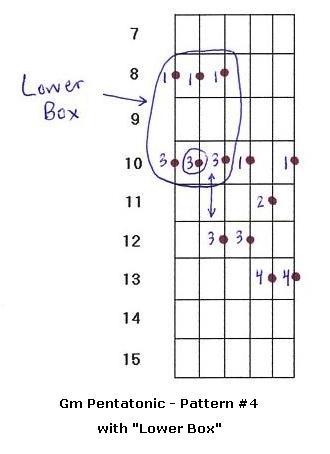
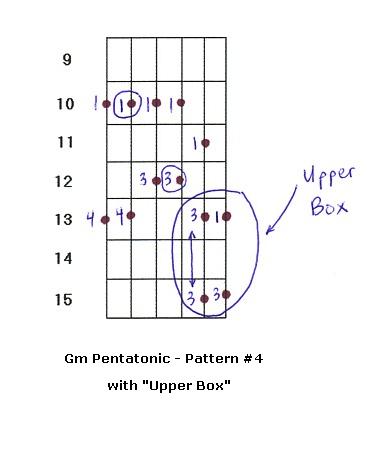
Diagrams 6 and 7: Pattern 4's Lower and Upper Boxes
Combining both boxes with Pattern 4 yields the following extended structure:

Diagrams 8: Pattern 4's Extended Structure
The two extended structures presented thus far are the ones most often used by guitar players.
Quite simply, they cover a lot of terrain - a "fretboard's worth of Blues", if you will.
See what you can do with the other pentatonic patterns (patterns 2, 3, and 5).
A Word About Fingerings:
When sliding between patterns there are no hard-set rules about which finger to use
when performing the slide. Sometimes the 3rd finger is appropriate, but sometimes the
1st finger is cool too. Sometimes even the second. It really depends on what you're playing.
Experiment on your own and try to figure out what works best for you. What you may
find is that the 3rd finger is good for both sliding up and down while the first finger
is better suited for sliding down and maybe only sometimes for sliding upwards. But, like
I just said, there are no hard-set rules. These are only my suggestions, let experience show
you what works best. And of course, do what feels right to you. Remember, don't take
anyone's technique too seriously. You'll drive yourself crazy if you do. Find your own way.
Switching Between Parallel Major and Minor Pentatonic Scales
Now if you ever listen to a great blues guitarist like B.B. King, one thing you'll
notice is how well he is able to switch between parallel major and
minor pentatonic scales. (Remember, the term parallel means that both scales share
the same root.)
So how does he do it? Well... very tastefully of course. But, here's a little trick that you
can use that seems to work for me. Use the root note as a
pivot note. Afterall, if we're switching between parallel scales
then it only makes sense to use the root as the note to switch off of.
Another way to state this idea is to "play around
the root."
Keep in mind, a lot can be said musically using this simple technique. Remember, your
imagination (or lack of one) is the only thing that really limits you in terms of
your musical creativity. Open your mind and don't be afraid to explore.
Look at the following two diagrams below for a few moments:
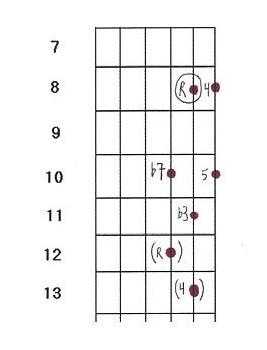
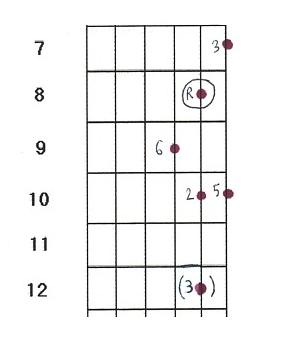
Diagrams 9 and 10 - Pivoting off the Root - Using G as the Tonic
Check it out: Stay in one position and use the root on the
B-string as the pivot note to switch between the two patterns. Why pivot on the
B-string? Well, you can use any root in any position on the guitar to pivot with,
but the B-string is a nice place to start because it places you in the upper-middle
register of the guitar's range which is ideal for soloing.
Setting up the pivot in G: What I do is usually
stay on the B-string placing my first finger on the root, the G.
Then I use my 3rd finger to cover the 9th (the A) and use my 4th
finger to cover the b3rd (the Bb). Pick up your guitar
and do this now - go to 8th position and put your first finger on the G.
Now, when I'm thinking/playing in "major mode" (over the "one" chord, G7,) I usually find
myself bending with my 3rd finger up to the 3rd of the chord - a bend starting on the
A and going up to the B.
And when I'm in "minor mode" I find myself bending with my 4th finger up to the 4th of the
chord - a bend starting on the Bb and going up to the C. (This is a
nice bend to do over the "four" chord too, over a C7.)
I also find myself approaching the root from below in two ways: In "major mode" I approach
it using the 6th (an E) with my second finger or when I'm in "minor mode" I approach
the root from the b7th (the F) with my 3rd finger. You can also slide
from the b7th on the G-string up to the root at the 12th fret.
Re-read the previous 4 paragraphs and make sure they make sense to you
before finishing this lesson. More importantly, try to execute the "bends" and "approaches"
I've just described here with your guitar as they contain the crux of the "pivot"
concept.
Now what?
The next best thing you can do is listen to B.B. King or Albert King play some guitar.
These two guitarists make use of the "pivot idea", using the patterns in diagrams 9 and 10,
extensively. Also, listen to some Jimmy Page as he plays some really tastey major/minor
pentatonic licks.
And of course I encourage you to record yourself playing a blues in G (or any key),
and then soloing over the changes using the two patterns above. Be sure to play
slowly at first as this is always the best way to develop your ear - your listening skills.
Don't know a blues progression? Well... here is a simple form you can use to help get you
started.
G7
/ / / / |
C7
/ / / / |
G7
/ / / / |
G7
/ / / / |
C7
/ / / / |
C7
/ / / / |
G7
/ / / / |
G7
/ / / / |
D7
/ / / / |
C7
/ / / / |
G7
/ / / / |
G7
/ / / / |
A Simple "12-bar Blues" in G
Start at the top left and work your way across each row, then repeat the progression from
the beginning once you finish playing the last measure. Also, each measure (cell in the table)
gets 4 beats. Notice the four hash marks in each measure? They signify 4 beats in one measure.
It's that easy.
As another exercise, try to find other places on the guitar where you can pivot off the root and
draw similar diagrams as diagrams 9 and 10 above. Then use these "newly discovered" patterns
over the above blues progression. And of course... start learning the licks and riffs of your
favorite blues/rock players as this is the sure-fire best way to develop your musical vocabulary.
Closing: And so ends yet another
chapter of the continuing saga known as musical education. I hope you've found some of
these ideas useful. Good luck and carry on!










